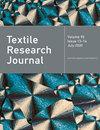Electrocatalytic recycling of indigo dye from waste denim fabric: an engineering approach toward efficient denim dye reuse
IF 1.9
4区 工程技术
Q2 MATERIALS SCIENCE, TEXTILES
引用次数: 0
Abstract
The denim fabric industry has experienced exponential growth and escalating concerns regarding sustainable production and recycling practices. The wide utilization of indigo dye in denim manufacturing presents significant challenges owing to its intricate chemical structure and inherent resistance to degradation. Improper disposal of waste denim fabric and the release of indigo dye impose severe ecological ramifications. In this study, we explore the productive application of electrochemistry to recycle indigo dye from waste denim fabric while repurposing the electrolyte for denim dyeing. Notably, the separation of indigo from waste denim textiles reaches 82.34%. It is calculated that 21.59 g of indigo can be recovered from 1 kg of denim waste. Recovered indigo can be reused for cotton yarn dyeing. In the experiment, indigo was recovered from 0.03 square meters of denim waste, and the K/ S value of the yarn was up to 2.997 after five dyeing cycles. The loss of fabric strength after recycling is as low as 13.32%, which has little effect on secondary fabric recycling. Our recycling method reduces the waste of 978.41 g of waste fabric and 21.59 g of indigo per kilo compared to conventional treatment. This research provides compelling scientific evidence supporting adopting a closed-loop system within denim production, underlining the potential for environmentally conscious and economically viable practices in the industry.电催化回收废牛仔布中的靛蓝染料:实现高效牛仔布染料再利用的工程方法
牛仔面料行业经历了指数式增长,人们对可持续生产和回收利用的关注也在不断升级。由于靛蓝染料复杂的化学结构和固有的抗降解性,其在牛仔布生产中的广泛使用带来了巨大的挑战。牛仔布废料的不当处理和靛蓝染料的释放会对生态环境造成严重影响。在本研究中,我们探索了电化学的生产应用,以回收废旧牛仔布中的靛蓝染料,同时将电解液重新用于牛仔布染色。值得注意的是,从废旧牛仔布中分离出的靛蓝达到了 82.34%。据计算,从 1 公斤牛仔布废料中可回收 21.59 克靛蓝。回收的靛蓝可重新用于棉纱染色。实验中,从 0.03 平方米的牛仔布废料中回收了靛蓝,经过五个染色周期后,纱线的 K/ S 值高达 2.997。回收后织物强度损失低至 13.32%,对二次织物回收影响不大。与传统处理方法相比,我们的回收方法减少了每公斤 978.41 克废织物和 21.59 克靛蓝的浪费。这项研究提供了令人信服的科学证据,支持在牛仔布生产中采用闭环系统,强调了该行业在环保意识和经济可行性方面的潜力。
本文章由计算机程序翻译,如有差异,请以英文原文为准。
求助全文
约1分钟内获得全文
求助全文
来源期刊

Textile Research Journal
工程技术-材料科学:纺织
CiteScore
4.00
自引率
21.70%
发文量
309
审稿时长
1.5 months
期刊介绍:
The Textile Research Journal is the leading peer reviewed Journal for textile research. It is devoted to the dissemination of fundamental, theoretical and applied scientific knowledge in materials, chemistry, manufacture and system sciences related to fibers, fibrous assemblies and textiles. The Journal serves authors and subscribers worldwide, and it is selective in accepting contributions on the basis of merit, novelty and originality.
文献相关原料
公司名称
产品信息
阿拉丁
ferrous sulfate (FeSO4)
阿拉丁
trietanolamine
阿拉丁
hydrated calcium gluconate
阿拉丁
sodium hydrosulfite
阿拉丁
sodium hydroxide (NaOH)
 求助内容:
求助内容: 应助结果提醒方式:
应助结果提醒方式:


